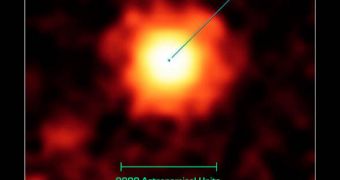Shortly after the planets inside our own solar system were formed, they began wobbling about, and roaming around, far from being caught in the well-defined orbits we see today. This chaotic motion is mainly responsible for the formation of the Moon, after Earth collided with a Mars-sized object that was circling the Sun on about the same orbit. These chaotic times have been history for billions of years, but, in other corners of the Universe, they are just starting. A set of observations, conducted with the Spitzer Space Telescope, now reveal such a planetary system, in the throes of orbital hyperactivity.
The system is encircled by a massive halo of dust, which is one of the main reasons why Spitzer was used for the studies. Infrared telescopes are the only observatories that can see through thick layers of dust, by identifying the heat signatures of objects beyond. Astronomers believe that the halo is being indirectly generated by the chaotic movement of planets circling their parent star, HR 8799. As they wobble uncontrolled, they influence the behavior of smaller, comet-like bodies, which then collide with each other in massive mash-up, and get pulverized.
According to experts at the NASA Jet Propulsion Laboratory (JPL), in Pasadena, California, the star was made famous in 2008, when it became one of the first ever celestial body to have the exoplanets around it imaged. The Hawaii-based W.M. Keck and Gemini observatories were used, at the time, to capture photos of three planets orbiting the far recesses of the system, each of them about 10 times the mass of Jupiter. Another star that revealed its orbiting planets was the more-aptly named Fomalhaut, which was imaged by the Hubble Space Telescope. Both stars are larger and younger than the Sun.
“The system is very chaotic and collisions are spraying up a huge cloud of fine dust. What's exciting is that we have a direct link between a planetary disk and imaged planets. We've been studying disks for a long time, but this star and Fomalhaut are the only two examples of systems where we can study the relationships between the locations of planets and the disks,” University of Arizona in Tucson (UAT) expert Kate Su explains. She was the leader of the Spitzer team that made the observations. The expert adds that the gravity the three exoplanets generate throw the smaller bodies into disarray.
The new study appears in the November 1 issue of the respected Astrophysical Journal, JPL reports on its news blog. The observations that used Spitzer were made before the telescope ran out of liquid coolant earlier this year, and began the “warm stage” of its mission.

 14 DAY TRIAL //
14 DAY TRIAL //